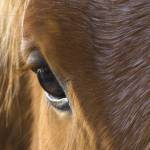Equine Cushing’s Disease: Australian and North American Differences

Season, age of horse, stress, geographical location, and even time of day affect hormone levels in a horse’s bloodstream. We know that equine Cushing’s disease, also called PPID or pituitary pars intermedia dysfunction, alters the production and secretion of multiple hormones, including ACTH or adrenocorticotropic hormone. Changes in these hormones result in the classic signs of Cushing’s disease: hypertrichosis or abnormal shedding, chronic laminitis, excessive sweating, and opportunistic infections, such as bacterial skin infections.
At least, that’s what happens to horses in the Northern Hemisphere. Despite the high population of horses in Australia, few studies have been published regarding equine Cushing’s disease on that continent.
“Successfully managing PPID horses relies heavily on an early diagnosis and rapid institution of both medication, pergolide, and dietary changes. Therefore, knowing whether dysfunction of the pars intermedia portion of the pituitary gland ‘looks’ the same in Australia as North America and Europe is very important,” explained Catherine Whitehouse, M.S., a Kentucky Equine Research nutrition advisor.
According to a recent study*, PPID in certain geographic regions, such as Australia, may not present as classically described, and milder PPID cases could be missed easily.
After testing 274 horses and ponies for PPID at eight veterinary facilities throughout Australia, the following data regarding PPID in the Southern Hemisphere were reported:
- Common clinical signs included hypertrichosis, lameness, tachypnea (increased respiratory rate), muscle loss, lethargy, abnormal fat distribution, weight loss, pendulous abdomen, hyperhidrosis or anhidrosis, and excessive drinking and urination;
- Clinical presentation of PPID changes with latitude and climate;
- Maintaining a higher body condition score was associated with increased survival, as was being a pony;
- Administering pergolide was also associated with survival; and
- Laminitis was diagnosed in 89.9% of cases, but a diagnosis of laminitis was not associated with survival.
“The presentation of PPID appears to vary based on geography. This suggests that the management of affected horses, particularly in reference to diet, may also need to be altered depending on where the horse resides,” suggested Whitehouse.
While researchers garner more information regarding the specific nutritional needs of PPID horses in various global regions, contact a Kentucky Equine Research nutrition advisor to start a discussion about your horse’s current needs. PPID negatively impacts every body system, including the integumentary (skin, hair, hooves) and musculoskeletal systems, so fully supporting these systems will help maintain quality of life for these animals.
*Horn, R., N.J. Bamford, T. Afonso, et al. Factors associated with survival, laminitis and insulin dysregulation in horses diagnosed with equine pituitary pars intermedia dysfunction. Equine Veterinary Journal 51:440-445.








